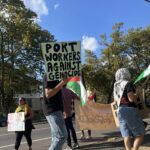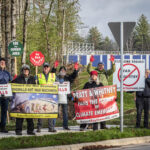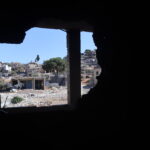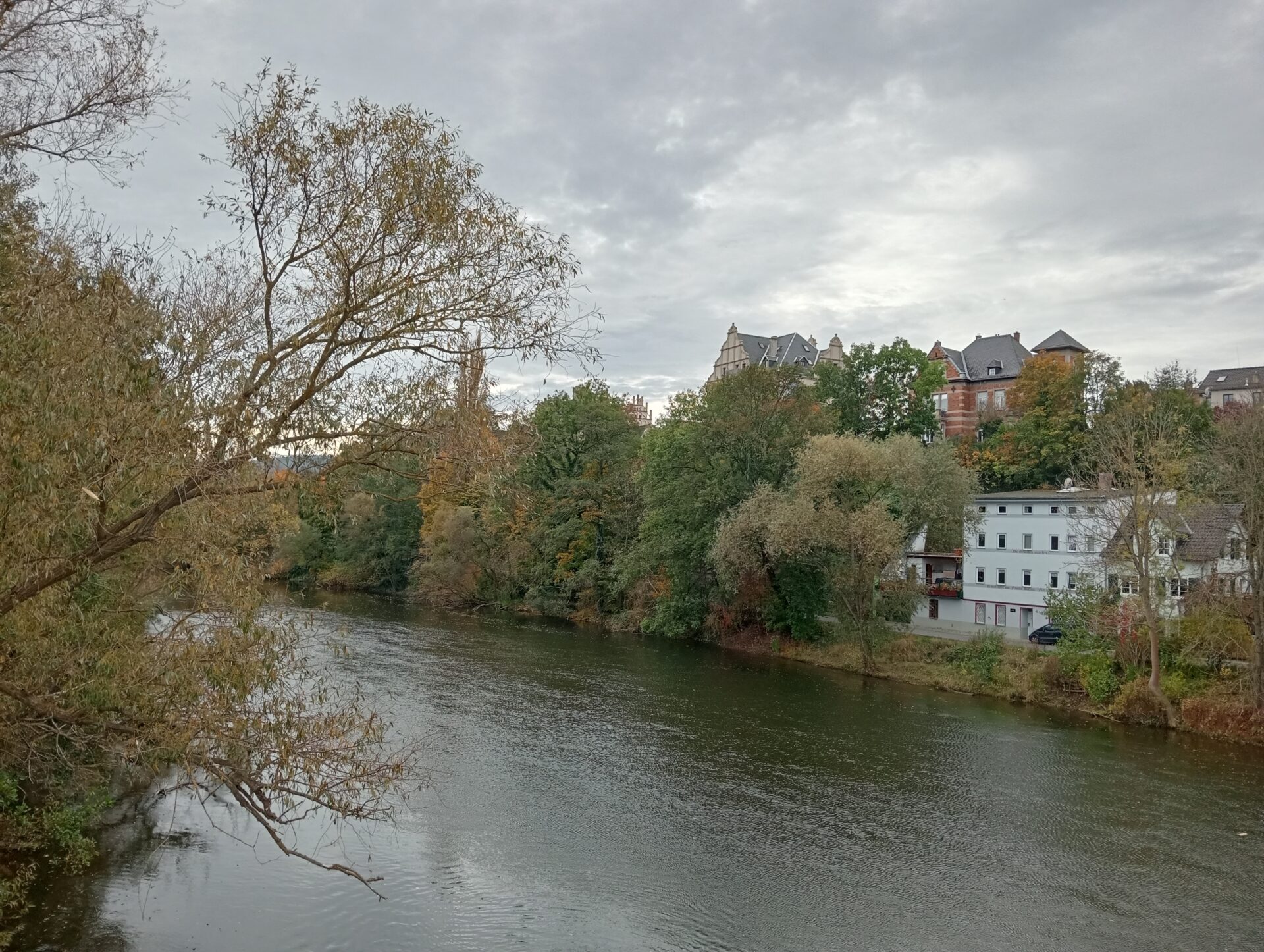Nowadays, the border between the German federal states of Bavaria and Thuringia is imperceptible. The regional train that connects the Bavarian city of Nuremberg and the Thuringian town of Saalfeld passes through forested hills punctuated by small villages in the lower areas, a tranquil landscape dotted with a stream.
But when arriving in Probstzella, the first village in Thuringia when traveling from Bavaria, there is a reminder that this wasn’t always the case. Between 1949, when the German Democratic Republic (GDR) — East Germany — was founded, and 1990, which marked the reunification of Germany, Probstzella was a border train station where around 20 million people were controlled.
Although US troops were the first to arrive at Thuringia, the territory — under the terms of a 1944 agreement between the Allies — was quickly transferred to Soviet troops, later becoming part of the GDR. Thirty-five years after the fall of the Berlin Wall on Nov. 9, 1989, which led to the reunification of Germany, there is no physical border between Bavaria and Thuringia anymore, but some significant differences remain.
The most obvious is the wealth gap. Whereas Bavaria is the federal state with the second highest GDP per capita, Thuringia has the lowest value in Germany — only 62% of the average Bavarian GDP. Apart from economic inequalities, there is also a representation gap, as few eastern Germans access the top positions in politics, education, or the private sector. These are grievances that the far-right has skillfully exploited, often using immigrants and refugees as scapegoats with political messages that have very real consequences.
Sonneberg, in Thuringia, elected in 2023 the first district head in Germany from the far-right Alternative für Deutschland (AfD). Since then, right-wing violence in the district has multiplied by five. In the whole of Germany, the number of criminal offenses committed by right-wing extremists has broken records for two consecutive years.
Amid the big turns of history, a closer look at Saalfeld, a town less than 15 km (9 miles) north of the border between Thuringia and Bavaria, elucidates the history of the two Germanies since 1949 and the reunited Federal Republic of Germany (FRG) since 1990.
Saalfeld, A Microcoosm of History
Saalfeld, a town of 29,071 inhabitants, prides itself on its thousand-year history and the nearby Feengrotten (Fairy Grottoes). The town and surrounding area are a microcosm of eastern Germany’s recent history. Although Saalfeld has long had an industrial base, agriculture is also an important economic activity. In this sense, it accorded with the GDR’s self-definition as “a socialist state of workers and farmers.” Saalfed was only atypical due to its closeness to the border, which represented a constant reminder that Germany was a divided country. After reunification, the economic upheaval in Saalfeld was very much in line with the experience in other regions of eastern Germany.
To enter Saalfeld’s city center, you have to cross a bridge over the river Saale. The current structure is a renovation of the bridge that was destroyed by the German army during the last days of the Second World War.
There are still traces of those days in the town. Next to the Saale Gate, a tower at the entrance of the town center, there is a plaque honoring the 208 Saalfelders who died after a US bombing on April 9, 1945. Another plaque commemorates the prisoners from the Buchenwald concentration camp, located 40 km (25 miles) north of Saalfeld, forcibly evacuated in “death marches” ahead of the US troops’ arrival.
Following the war, the most immediate concerns in the region, as in so many other areas of Germany, were housing and adequate food supplies. In a situation of severe scarcity, the new Communist regime privileged those who were deemed politically reliable and workers considered key to the economic recovery of the Saalfeld area. Those who worked at the Maxhütte steel mill, close to the town of Saalfeld, received preferential treatment. The factory, dubbed the “Mother of the Metallurgy” because it remained the only steelworks in the GDR until the early 1950s, was seen as essential for the reconstruction of the country.
The FRG, which could count on the economic potential of the Rhein-Ruhr industrial region, profited from massive US investment in Europe under the framework of the Marshall Plan to recover from the war. Meanwhile, the GDR was severely weakened by Soviet looting at the end of the war and the ongoing reparations imposed by Moscow.
A Town in Communist Germany
The groundwork for the split between the two Germanies was laid in the 1950s. During this decade, the GDR’s government implemented a program of land collectivization that sought to break up the old structures of aristocratic domination in the countryside. In Saalfeld, the land collectivization process had a slow start. Many low-income farmers in the area often believed they were better off cultivating their lands independently of the newly-created agricultural collectives, or preferred to wait and see before making a decision. Under increased pressure, however, land collectivization was virtually completed by the early 1960s.
During the 1950s, there was still a significant flow of people between West and East Germany that had important effects on Saalfeld, in part because of its geographic proximity to the FRG. Although around 800 people arrived in Saalfeld from the FRG before the building of the Berlin Wall, most Germans took the opposite direction. During the four years before 1961, over 2,200 Saalfelders moved to the West. Young people were more likely to leave, and some of those who abandoned Saalfeld were the kind of skilled professionals the GDR could not afford to lose in the effort to rebuild the country. The motivations for leaving were manifold, from personal reasons to a desire for higher salaries and greater political freedoms.
The Border Closes
The opportunity to leave practically disappeared in 1961, with the construction of the Berlin Wall and the closure of the inner German border. This was “a form of national house arrest”, writes the historian Mary Fulbrook. At the same time, it brought stability to the GDR’s regime. A specific example of this relative calm can be observed in the winter of 1969 to 1970. Even though there was a shortage of food and energy in the GDR because of record-low temperatures, public discontentment was very restrained, and Saalfeld saw no civil unrest.
Especially during the 1970s and 1980s, the GDR engaged in a major construction program of prefabricated buildings (Plattenbau) to provide affordable housing to the population. In Saalfeld, the first Plattenbau was built in Gorndorf, on the outskirts of the town, in the 1960s.
In 1971, Walter Ulbricht was replaced by Erich Honecker as leader of the GDR. Under Honecker, social benefits improved and the agricultural sector underwent a mechanization process. In the industrial sphere, advanced technology programs were introduced to catch up with Western Germany. Two of these new industrial plants were located in Thuringia, in the cities of Erfurt and Jena, but not in Saalfeld. The economic modernization program led to higher levels of debt in the 1980s. Meanwhile, the GDR’s political police, the Stasi, was more coercive than in prior decades. According to an estimate, around 7,000 people were working for Stasi in Thuringia by 1989, the last year of the GDR. Saalfeld, but also larger population centers in Thuringia, remained a backwater to the protests in Leipzig, Berlin, and Dresden that hastened the collapse of the GDR.
The Reunification Shock
On Oct. 3, 1990, Germany was reunified. Saalfeld, Thuringia, and the other areas that belonged to the GDR experienced an immense shock after reunification. In came new political freedoms, such as freedom of association and open elections but also severe economic upheaval. The first free and fair regional elections in the former GDR took place in October 1990. They were won, both in Saalfeld and the whole of Thuringia, by the center-right Christian Democratic Union (CDU) of German chancellor Helmut Kohl, who had completed the reunification process only days before the elections. There was initial trust that the “flourishing landscapes” Kohl had promised for the East would materialize.
The economic structure of the former GDR, which had largely been in the hands of the state, underwent a quick privatization process. The Treuhand, an agency created to transfer ownership from the decaying GDR state to private hands — most often, those of Western German investors — was behind these dramatic changes.
The Maxhütte, once the “Mother of the Metallurgy” in the GDR, became the private company “Stahlwerk Thüringen” in 1992, under the control of a corporation from Luxembourg. The factory has changed owners multiple times since then and is now owned by a Brazilian company. The Rotstern chocolate factory, meanwhile, was by 1991 already in the hands of Stollwerck, a chocolate manufacturer then headquartered in Cologne, western Germany. A former worker at Rotstern commented in 1992 to a reporter of the weekly magazine Der Spiegel that “this is not our company anymore” and the “company climate is not like before.”
After 1990, four out of five eastern Germans lost their jobs or had to change their working places. This was all the more traumatic because Eastern citizens were not used to unemployment, which had been almost nonexistent in the GDR. In 1991, one year after reunification, unemployment in the former GDR was around 10%. By the decade’s end, it was close to 20%, and would remain very high during the early 2000s before falling rapidly later.
In Thuringia, unemployment remained above 16% in the decade between 1996 and 2005. In a process replicated in many other areas of the former GDR, Thuringia experienced a steep decline in its birth rate and lost 7% of its population in the first decade after reunification. Saalfeld, with a population of 32,349 people in 1994, was below 25,000 inhabitants in 2016 and only rose later in population due to administrative changes that widened the area of the town.
The Rise of the Far-Right
Once incorporated into the political system of the FRG, the areas that formerly belonged to the GDR have retained their political specificities. One of these specificities is lower levels of party membership among the population. The center-right CDU and the center-left Social Democratic Party of Germany (SPD) — the only two parties to have appointed a chancellor after the Second World War — combine for a smaller share of the vote in eastern Germany than in the rest of the country. In the last elections to the German parliament in 2021, the two parties combined for 50% of the votes in the whole of the country, 41% in former GDR areas and a meager 37% in Saalfeld.
Since reunification, a significant segment of the vote in eastern Germany has gone to two parties that have been perceived as representing eastern interests. The Party of Democratic Socialism (PDS) was the successor of the Socialist Unity Party of Germany (SED), the ruling party in the GDR. It would later merge with left-wing Western groups to constitute a new party, Die Linke, in 2007.
The PDS, and later Die Linke, managed to gain close to or even more than a fifth of the votes in former GDR areas in every German election until 2017, which marked the entry to the German parliament of the far-right Alternative für Deutschland (AfD). AfD has managed to capture votes from all other parties while taking away Die Linke’s mantle as the representative of eastern Germany. In the last German-wide elections in June 2024, when Germany chose its representatives in the European Parliament, the AfD obtained 29% of the votes in the areas of Germany that belonged to the GDR. Die Linke had to content itself with 5.3%.
So far, however, the most significant AfD election successes have come in eastern Germany. In the last European election, the far-right party finished first in the five federal states that belonged to the GDR.
The profile of these two parties is very different. The PDS/Die Linke gained credibility among voters as a defender of workers’ rights amid the wave of privatization and unemployment that followed reunification. Meanwhile, the AfD has a neoliberal profile and has been exploiting xenophobic grievances after the arrival of over a million asylum seekers in Germany in 2015. The AfD has also established a strong foothold in areas outside of the former GDR that Die Linke could not even dream of in its best days, with 13% of the votes in western Germany in the June 2024 European elections.
So far, however, the most significant AfD election successes have come in eastern Germany. In the last European election, the far-right party finished first in the five federal states that belonged to the GDR. In September 2024, the AfD won the regional elections in Thuringia. Their victory, with 33% of the vote, represented the first win for a far-right party in a regional election in Germany since the end of the Second World War.
The town of Saalfeld, which gave 34% of its votes to AfD, and even more with the rural areas surrounding it, were among the places that contributed to this unprecedented result. This is hardly surprising. The AfD obtains better results in rural areas and, more generally, in parts of the country that are going through a process of de-population. Part of AfD’s success in eastern Germany is due to it being more rural and having undergone major de-population after reunification.
At the same time, there are simply more grievances for the AfD to exploit in eastern Germany. The economic inequalities between eastern and western Germany remain prominent to this day. Eastern Germans inherit, on average, nine times fewer assets than their Western counterparts. The average salary is also 20% lower in the areas that belonged to the former GDR, and the gap has barely narrowed in the last two decades.
Almost eight decades after the end of the Second World War, and thirty-five years after Germany’s reunification, the echoes of the country’s division continue to shape politics today.














